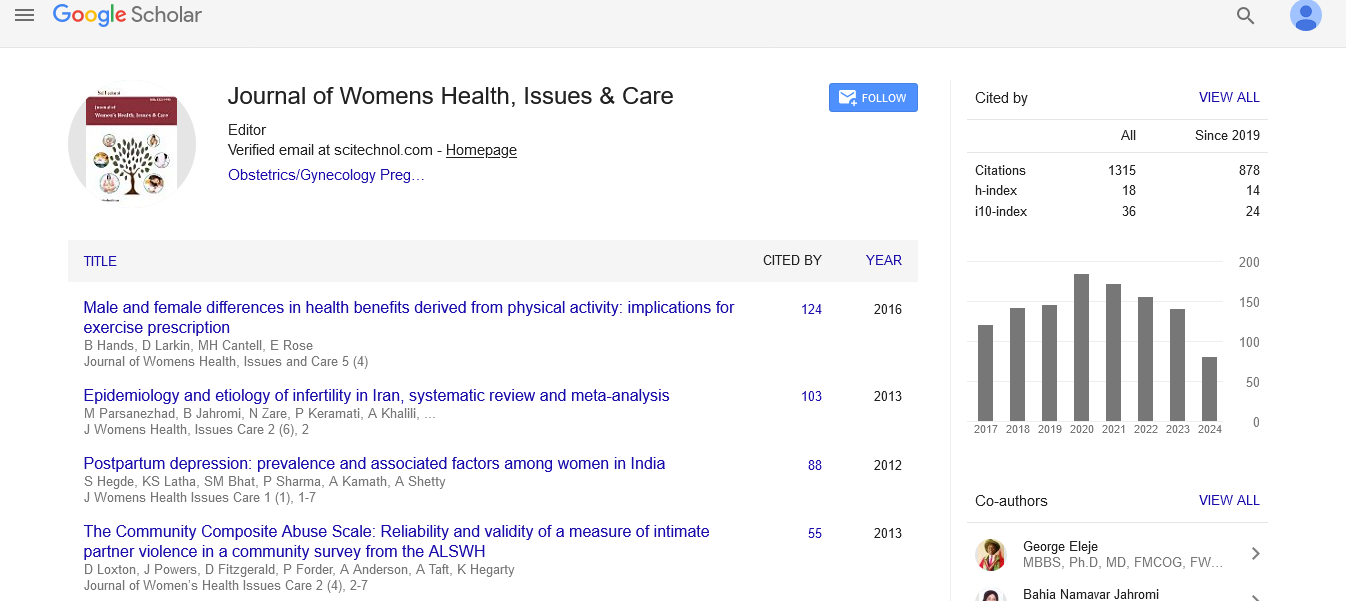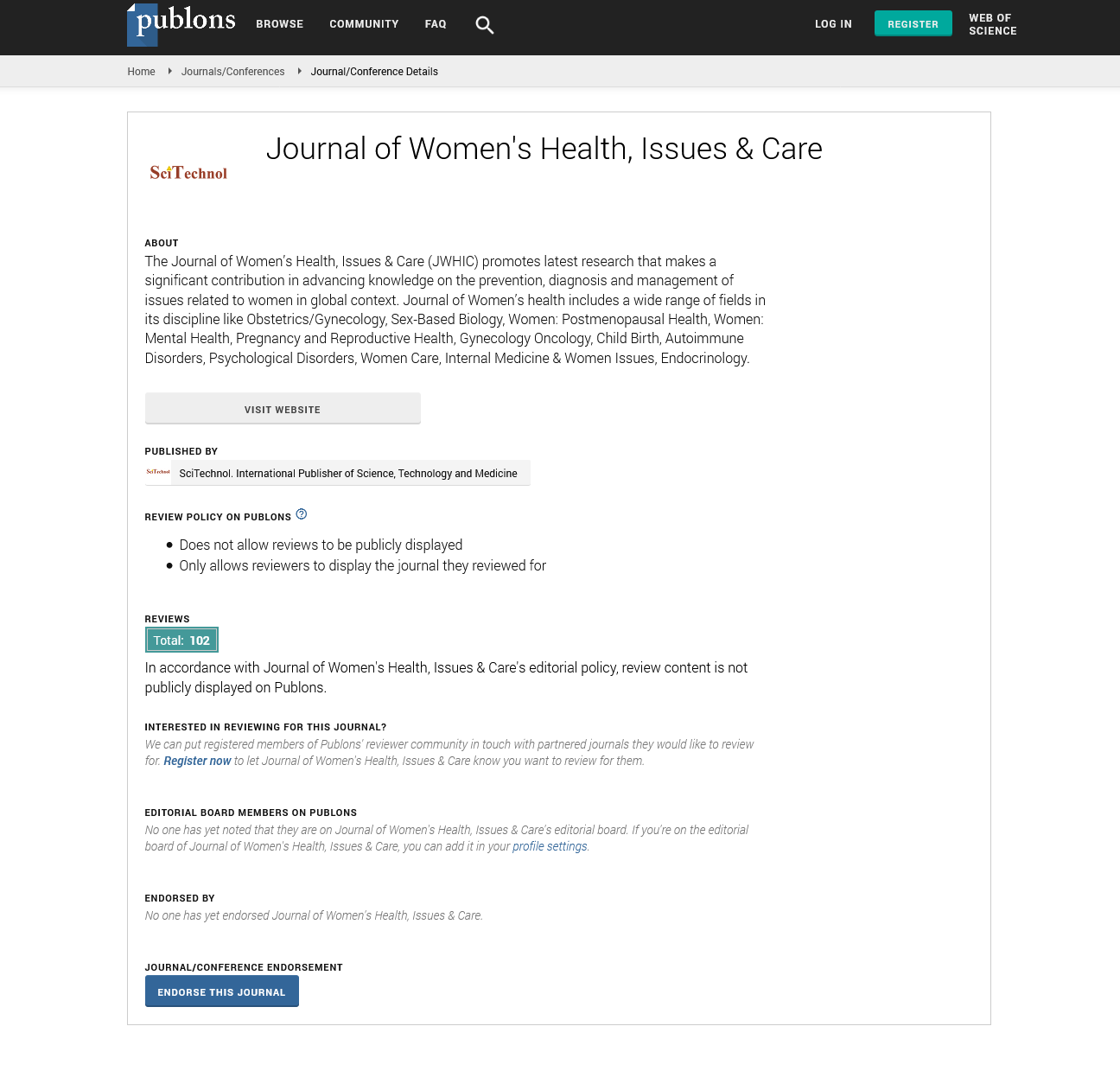Perspective, J Womens Health Vol: 13 Issue: 6
Age-Related Diseases in Women: Dementia and Alzheimer’s
Kaliyia Lokuni*
1Department of Geriatric Psychiatry, Pavlov First Saint Petersburg State Medical University, St. Petersburg, Russia
*Corresponding Author: Kaliyia Lokuni,
Department of Geriatric Psychiatry,
Pavlov First Saint Petersburg State Medical University, St. Petersburg, Russia
E-mail: kaliyia_lokuni78@gmail.com
Received date: 26 November, 2024, Manuscript No. JWHIC-24-156664;
Editor assigned date: 28 November, 2024, PreQC No. JWHIC-24-156664 (PQ);
Reviewed date: 12 December, 2024, QC No. JWHIC-24-156664;
Revised date: 20 December, 2024, Manuscript No. JWHIC-24-156664 (R);
Published date: 27 December, 2024, DOI: 10.4172/2325-9795.1000534.
Citation: Lokuni K (2024) Age-Related Diseases in Women: Dementia and Alzheimer’s. J Womens Health 13:6.
Description
As women age, they face an increased risk of developing agerelated diseases, with dementia and Alzheimer’s disease being among the most concerning. These conditions are characterized by a decline in cognitive abilities, including memory, reasoning and decisionmaking and are often more prevalent and severe in women compared to men. The relationship between aging and these neurodegenerative diseases is important for improving prevention, diagnosis and care strategies. Dementia is a broad term that encompasses various conditions involving a decline in cognitive function, affecting daily life and activities. Alzheimer’s disease, the most common form of dementia, accounts for approximately 60%-80% of all dementia cases. Alzheimer’s is a progressive disease that typically starts with mild memory loss and confusion and worsens over time, ultimately leading to the inability to perform basic tasks. While Alzheimer’s can affect both men and women, research has shown that women are disproportionately affected. In fact, nearly two-thirds of those living with Alzheimer’s are women and women in their 60s are more likely to develop Alzheimer’s than breast cancer.
The reasons why women are more susceptible to dementia and Alzheimer’s are complex and multifactorial. Biological, hormonal and genetic factors all play a role in this increased risk. One of the most significant factors is the role of estrogen, the primary female sex hormone. Estrogen has been shown to have neuroprotective effects and as women enter menopause and experience a decline in estrogen levels, they may become more vulnerable to the onset of Alzheimer’s disease. Some studies suggest that the decrease in estrogen might accelerate the accumulation of amyloid plaques and tau tangles in the brain, which are characteristic of Alzheimer’s pathology. Genetic factors also contribute to the higher incidence of Alzheimer’s in women. The most well-known genetic risk factor is the Apo Lipoprotein E (APOE) gene, specifically the APOE4 allele. While both men and women with the APOE4 allele are at higher risk for Alzheimer’s, women with this genetic variant appear to be at an even greater risk than men. Researchers are still investigating the mechanisms behind this gender disparity, but it is clear that women with certain genetic predispositions are more likely to develop Alzheimer’s than their male counterparts.
Social and lifestyle factors also play a role in the development of dementia and Alzheimer’s in women. Women generally have a longer life expectancy than men, which means they are more likely to live into the age range where dementia and Alzheimer’s are most prevalent. Additionally, women are more likely to experience conditions that can increase their risk of cognitive decline, such as depression, chronic stress and less engagement in physical or mental activities that promote brain health. Social isolation, often more common among elderly women, has also been linked to an increased risk of dementia.
In terms of symptoms, dementia and Alzheimer’s in women manifest similarly to men, but women tend to experience a faster progression of the disease. Women may also show different patterns of cognitive decline, with a greater emphasis on memory loss and language difficulties early on. As the disease progresses, women often face more severe symptoms, including confusion, mood swings and difficulty recognizing family members and friends. The impact of dementia and Alzheimer’s on women goes beyond just the individuals affected. The caregiving burden is often disproportionately assumed by women, who are more likely to be family caregivers with dementia. This caregiving role can have significant emotional, physical and financial implications, particularly as the disease progresses and the caregiving demands increase. The strain on female caregivers is an important consideration in the societal impact of these diseases.
Conclusion
In conclusion, dementia and Alzheimer’s disease represent significant age-related health challenges for women. With the increasing aging population, it is essential to raise awareness about the gender disparity in these diseases and promote research into their causes, prevention and treatment. The unique risk factors and providing support for both individuals affected by the disease and their caregivers, society can better manage the growing impact of dementia and Alzheimer’s on women’s health and well-being. Regular physical activity, a healthy diet rich in antioxidants and omega-3 fatty acids, mental stimulation through puzzles or learning new skills and social engagement are all associated with a lower risk of cognitive decline. Additionally, managing chronic health conditions such as diabetes, hypertension and depression can help protect against the onset of dementia.
 Spanish
Spanish  Chinese
Chinese  Russian
Russian  German
German  French
French  Japanese
Japanese  Portuguese
Portuguese  Hindi
Hindi 



